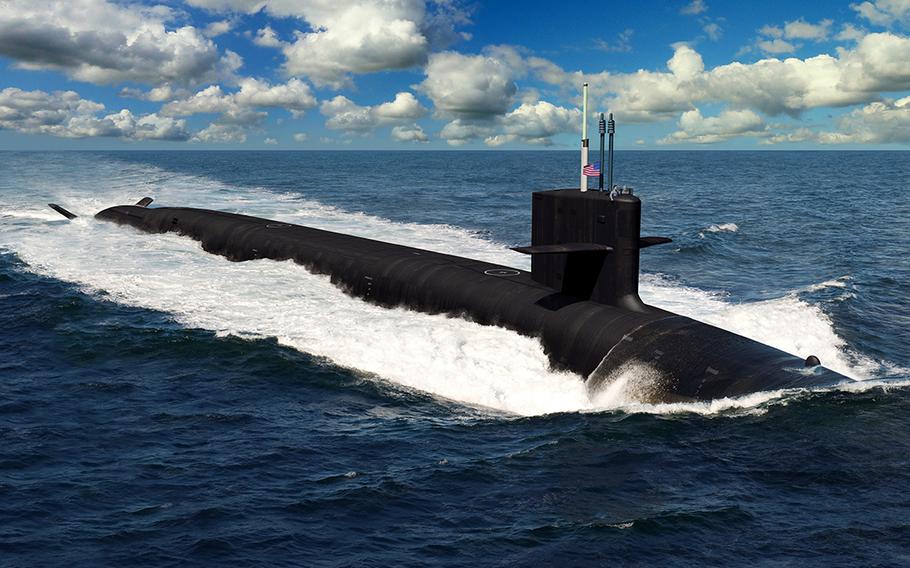
An artist rendering of the future Columbia-class ballistic missile submarines. The 12 submarines of the Columbia class are a shipbuilding priority and will replace the Ohio-class submarines reaching maximum extended service life. (U.S. Navy illustration)
(Tribune News Service) — In the stern section of the submarine pressure hull under construction at Newport News Shipbuilding are signs of a new kind of relationship in American business.
Two shipyards — Newport News Shipbuilding and General Dynamics Electric Boat — that were once competitors in building submarines are now collaborating with the Navy in design and engineering work for the nuclear fleet.
“It’s grown over time ... we each bring our strengths to this,” said Charles Southall, Newport News’ vice president of Columbia-class Submarine Construction.
Newport News and Electric Boat teamed up for construction of Electric Boat-designed Virginia class submarines two decades ago. Each builds set portions of those submarines — Newport News makes the bows, sterns and sails — and they take turns on the final assembly.
But when Newport News began design and engineering work on the aircraft carrier Gerald R. Ford years later, engineers and designers from Electric Boat joined in. They had worked on the challenges of keeping fluids flowing through piping as the bows of Virginia class boats plowed through the ocean. The answers they found became part of the Ford’s design and engineering.
And when the Navy began thinking about a new ballistic missile submarine some 25% larger than its four-decade old Ohio-class boats, Electric Boat turned to Newport News to design and solve the engineering challenge of making and assembling complexly curved steel into bows and sterns and sails.
“When you think about our shipbuilders, the craftswomen and craftsmen in the North yard who work with those digital tools, cutting and shaping heavy steel to make those curves — there are entire nations that would give everything to have what we can do in Newport News today,” Southall said.
The yard’s designers and engineers have to determine how many pieces of what shape are needed and how to bend them along multiple axes so they can be welded into the dome-like bow and the curved conical shape of the stern.
They do that for the pressure hull and for the tanks that can either keep a sub at the surface or in the depths when filled with air or water, as well as the outer skin of the boat and its diving planes.
Shipyard engineers developed tools and processes for making the biggest subs in the American fleet, including the giant fixtures in the JMAF that can lift and flip up to 900 tons, while automatically moving work stations into place.
At the moment, shipbuilders are working on the stern pressure hull for the first Columbia-class submarine.
When the pressure hull, tanks, outer hull and equipment are all assembled, the stern — the first module of six the shipyard is building for the first two subs under a $2.2 billion contract, will be shipped to Electric Boat. The date for that is November 2022.
Shipbuilders already are working on the lead boat’s bow and last week made the first cut of steel for the second boat’s stern. They’ll deliver the lead boat’s down in 2025 and the last of the modules for the first two Columbia class submarines by January 2028.
Electric Boat, meanwhile, is to deliver the first Columbia submarine in 2027.
“Electric Boat is on an extremely tight timeline to deliver this asset for national defense — we understand that, and so delivering on time is as important to us as if we were doing final assembly,” Southall said.
Unlike the Virginia class teaming arrangement, under which Newport News and Electric Boat had been alternating final assembly work, Columbia class boats will be assembled at Electric Boat.
Newport News will handle about 22% of the work on Columbia class boats, but is picking up a larger share of work on Virginia-class submarines.
The Columbia contract marks a return to working on submarines that carry missiles with nuclear warheads. Newport News did not work on Ohio-class boats; the last ballistic submarine it build was the USS George Washington Carver, which was commissioned in 1966 and scrapped in 1994.
The Columbia class will replace the fleet of Ohio-class ballistic missile submarines.
The Navy has said it expects the 12 submarines will cost $109 billion.
©2021 Daily Press. Visit dailypress.com. Distributed by Tribune Content Agency, LLC.